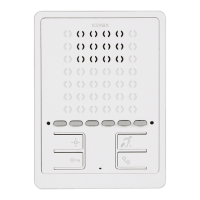GB
12
Fig. 2.3
Fig. 2.4
Hearing aid function (art. 7509/D only)
Art. 7509/D has an internal coil which allows hearing aid wearers to use the
device. In this operating mode, the hearing aid must be switched to the “T”
position. However, for correct operation of the hearing aid refer to its in-
struction manual.
Note: metal objects or electronic equipment in the vicinity may affect the
quality of the sound received by the hearing aid.
Configurations
Choice of ringtones
10 different ringtones can be selected. Different ringtones can also be set
for outdoor, intercommunicating and door calls (see below). The ringtones
must be selected with the interphone/monitor on stand-by and the handset
on the hook.
The button for entering configuration mode is button A (self-start).
Button E1 selects the ringtone for ENTRANCE PANEL CALL.
Button E2 selects the ringtone for INTERCOMMUNICATING CALL.
Button E3 selects the ringtone for DOOR CALL (exclusively using the but-
ton interface module 6120 or Vimar landing call button). In the case of a
door call by means of a button connected directly to the interphone’s ter-
minals FP and M, the ringtone cannot be changed.
Configuration:
1) Press button A (self-start) and hold down (for 2 s) until the LED G
“door/gate open” begins flashing and the interphone emits an audible
signal.
2) Press and hold down the button for the chosen ringtone (button
E1/button E2/button E3) until the ringtone is heard on the interphone.
3) Press the button repeatedly (button E1/button E2/button E3) to select
the desired type of ringtone.
4) After choosing the desired ringtone, press button A or refrain from tou-
ching any buttons for 5s to save. After completing the configuration, the
LED flashes and then turns off.
Ringtone volume adjustment
The ringtone volume can be set to 6 levels plus mute.
Press button A (self-start) to enter configuration mode.
Press button B (bell) to lower the ringtone volume.
Press button C (key) to increase the ringtone volume.
The ringtone volume must be adjusted with the interphone/monitor on
stand-by and the handset on the hook.
Configuration:
1) Press button A (self-start) and hold down (for 2 s) until the LED G
“door/gate open” begins flashing and the interphone emits an audible si-
gnal.
3) Press button B to lower or button C to increase the volume. Each time
the buttons are pressed the volume changes by one level.
4) After choosing the desired volume, press button A or refrain from tou-
ching any buttons for 5s to save. After completing the configuration, the
flashing LED goes off and a “beep” is emitted.
Muting the ringtone (User Away function)
Using the volume adjustment procedure described above, pressing button
B a sufficient number of times results in the ringtone being muted. The “Rin-
gtone muted” status is indicated by the LED F (ringtone muted) lighting up
steadily.
If the interphone receives a call from the entrance panel while the ringtone
is muted, this is indicated by the LED F (ringtone muted) emitting one flash
for each unanswered call up to a maximum of 4 calls (these flashes occur
every 10 s). When the ringtone volume is restored, at least to its minimum
level, this indication will be reset.
Bus termination for video signal stabilisation
The BUS termination dip-switches for video signal stabilization are located
inside the interphone.
Depending on the connection configuration (interphones/monitors connec-
ted in series or derived from a distributor), set the dip-switches in the ap-
propriate position (position A, B or C) according to the instructions given
in the note “Bus termination for ELVOX TWO-WIRE INSTALLATIONS” in
the wiring diagrams section below.
Dip-switch for
Bus termination

